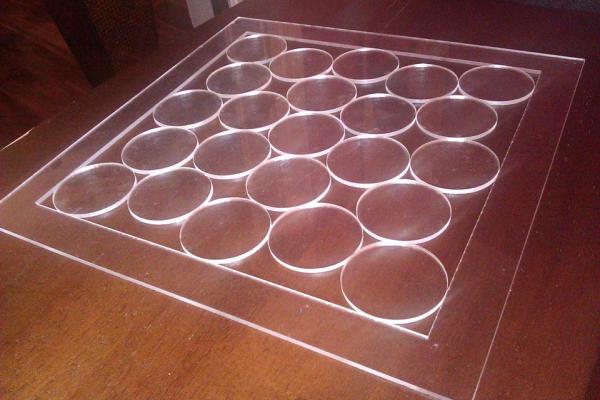Circle Packing offers discovery, surprise

One thing Matt Kahle has learned is that there is more than one way to solve a puzzle.
Kahle, Assistant Professor in the Department of Mathematics, recently completed the first version of his circle and square packing puzzles by teaming up with Alex Bandar at the Columbus Idea Foundry.
Circle packing is the study of the arrangement of circles of equal or varying sizes on a given surface such that no overlapping occurs and so that all circles touch another. The associated "packing density" of an arrangement is the proportion of the surface covered by the circles.
"So often we do math abstractly, in our heads, but I think even then we are often using our visual cortex," Kahle says. "I wanted a way to play with a math problem, using our hands and eyes."
Kahle explains that packing circles and spheres in space has occupied mathematicians and physicists for hundreds of years. Only a few years ago, Thomas Hales proved "Kepler's conjecture" that the densest packing of spheres in 3-dimensional space is the face-centered cubic "cannonball" packing, for which proof was incredibly difficult to obtain and required extensive computer calculations.
"Most of this body of work is on packing objects in Euclidean space, which is infinite. But the problems become even harder if you try to pack them in a finite region, such as a square," Kahle says.
To begin the project Kahle gave Bandar all the specifications, including exact dimensions for each puzzle. Through The STEAM Factory’s Outreach and Engagement Impact Grant, Bandar was able to laser cut the packing circles to specifications.
For the puzzle to turn out correctly, the laser cutting had to be a precise process.
"When laser cutting the pieces, there is a kerf of roughly 0.005 inches on every cut, on the pieces and on the frame itself," Kahle says. "Compensating for this is very tricky, because the circles fit together in such complicated geometric ways. It is important to get this correct, because we want the pieces to fit together just right, and to be pleasing as a puzzle."
Bandar says it was one of his most technically demanding laser cutting projects yet.
"Although very fine, the thickness of the cut that the laser makes is not negligible. This is rarely an issue for artistic projects, or even for most assembly projects," Bandar says. "However, since even a small amount of slop might mean it would be possible to press an extra circle or square into the puzzle’s frames, it took quite a bit of iteration to get the process down right."
When Kahle and Bandar finally worked out the kinks, they were able to take their project and share it with others.
Discovering how different people solve puzzles in different ways is one result that makes the project worthwhile for the two.
"We brought the puzzles to The STEAM Factory's booth at the 400 W. Rich winter market, to let people play with them when a brilliant third grader, Declan Dougan, found a beautiful packing of 23 disks in a square that we were previously unaware of," says Kahle. "That was something that was unexpected and really neat."
